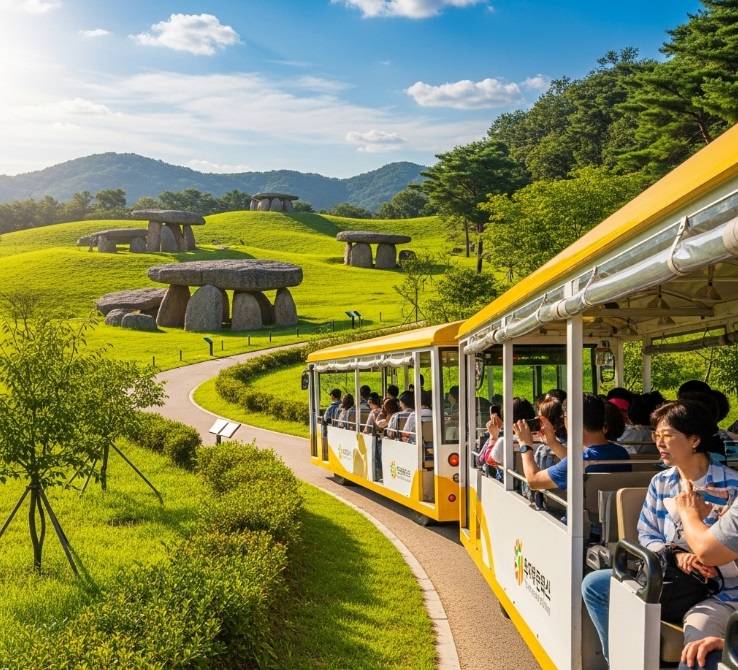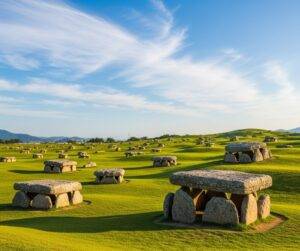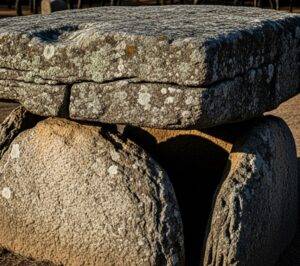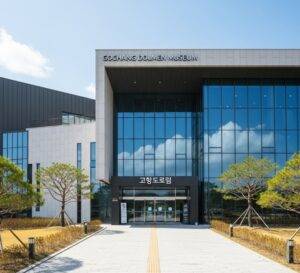For the traveler who seeks to touch the annals of deep time, few places in South Korea offer a more profound connection to the past than the Gochang Dolmen Sites. Far from the glittering skylines of Seoul, this quiet corner of Jeollabuk-do province holds the largest and most concentrated collection of prehistoric megaliths on Earth. This is not merely a tourist stop; it’s a journey into the heart of Bronze Age Korea. Completing a Gochang dolmen sites tour is an opportunity to stand in the presence of ancient history, and this guide will provide the historical context and practical logistics to do it right.
As we are now in late August 2025, planning your visit for the upcoming autumn months of September and October is ideal. The cooler, pleasant weather is perfect for exploring the sprawling outdoor sites and appreciating the landscape that these ancient peoples called home.
What Are Dolmens? A Glimpse into Prehistoric Korea
Before embarking on your journey, it’s essential to understand what you’re about to witness. Dolmens are megalithic tombs, typically consisting of two or more large upright stones supporting a massive horizontal capstone. These structures are some of the most significant prehistoric sites in Korea, dating back to the 1st millennium BCE during the Bronze Age.
Far from being simple graves, these ancient tombs in Korea were monumental structures that served as burial markers for the ruling elite. The sheer effort required to quarry, transport, and erect these multi-ton stones speaks to a sophisticated social structure and a powerful belief system centered on commemorating the powerful dead. They are a tangible link to Korea’s Megalithic culture and provide invaluable clues about the rituals, technologies, and social hierarchies of a civilization that left behind no written records.
The Gochang, Hwasun & Ganghwa Sites: A Collective UNESCO Treasure
The Gochang sites do not stand alone in their significance. In 2000, UNESCO designated them as a World Heritage site collectively with similar sites in Hwasun and Ganghwa. This grouping of UNESCO sites in South Korea was chosen because together, they present an unparalleled density and variety of dolmens, showcasing the global peak of Megalithic culture. While Hwasun and Ganghwa are also remarkable, Gochang is often considered the premier destination due to the sheer number—over 1,600 dolmens—and the exceptional preservation of its clusters.
Planning Your Gochang Dolmen Sites Tour
With a grasp of the historical weight of your destination, we can now turn to the practicalities of your expedition. This section provides a clear, step-by-step plan for your visit.
How to Get to Gochang
For most independent travelers exploring the Jeolla region, the most efficient way to visit is as a day trip from Jeonju to Gochang. Jeonju’s excellent transportation hub and vibrant cultural scene make it the perfect base.
- Depart from Jeonju Intercity Bus Terminal: Navigate to the main bus terminal in Jeonju. The terminals are well-organized with clear signage in English.
- Purchase Your Ticket: Go to the ticket window and ask for a ticket to Gochang (고창). Buses run frequently throughout the day, roughly every 30-40 minutes. The journey takes approximately 1 hour and 30 minutes.
- Arrive at Gochang Bus Terminal: From the Gochang Bus Terminal, the dolmen sites are still a few kilometers away. Your best option is to take a local taxi. The ride to the Gochang Dolmen Museum is short, about 10-15 minutes. Show the driver the museum’s name: Gochang Dolmen Museum (고창고인돌박물관).
A Step-by-Step Guide to Exploring the Sites
Your visit will center around the main museum, which acts as the gateway to the sprawling historical park.
How to Visit Gochang Dolmen Museum
The Gochang Dolmen Museum (고창고인돌박물관) is your mandatory first stop. It is the central hub where you purchase tickets and get oriented.
- Location: The museum is located at the entrance of the main dolmen preservation area.
- Opening Hours: 9:00 AM to 6:00 PM (last admission at 5:00 PM).
- Important Note: The museum is closed every Monday and on January 1st. Plan your trip accordingly to avoid disappointment.
- Tickets: You will purchase a single integrated ticket here that covers admission to the museum and a ride on the tourist train, which is essential for exploring the vast site.
The museum itself is excellent, offering well-curated exhibits that explain the history of the dolmens, Megalithic culture, and the Bronze Age way of life. Spend at least an hour here to fully appreciate the context before heading out to the fields.
Touring the Dolmen Clusters
The dolmen sites are far too spread out to explore entirely on foot. The tourist train (a tractor-pulled tram) that departs from the museum is the best way to see the main clusters.
- The Tourist Train: The train follows a set route with multiple stops, allowing you to get off, explore a dolmen cluster, and catch the next train.
- Main Courses: The route typically covers the most impressive and accessible dolmen groups. You’ll see various styles, from the table-like “northern” type to the go-board-like “southern” type.
- Exploration: As you ride through the park, you’ll be struck by the sheer number of these megaliths dotting the landscape. Take your time at each stop to walk among the tombs. The feeling of standing beside a 3,000-year-old monument, placed with intention by a long-vanished people, is truly humbling.
Where to Stay: Base Yourself in a Nearby City
Gochang itself offers limited accommodation options suitable for international travelers. For greater comfort, dining choices, and accessibility, basing yourself in a larger nearby city is highly recommended.
- Jeonju: The ideal choice. It’s famous for its beautiful Hanok Village, delicious bibimbap, and excellent transport links, making it a perfect cultural base for your historical day trips.
- Gwangju: Another excellent option, Gwangju is a larger metropolitan city with extensive amenities and is also relatively close to Gochang.
Actionable Tip: Find the perfect hotel in Jeonju for your historical day trips.
Conclusion: A Journey into Deep Time
A visit to the Gochang Dolmen Sites is more than just ticking off a UNESCO location. It is a quiet, contemplative experience that connects you to the very dawn of Korean civilization. Standing before a 50-ton capstone, perfectly balanced by people with only rudimentary tools, you are forced to contemplate the ingenuity and spiritual depth of our ancient ancestors. It is a journey that requires a little effort, but the reward—a tangible connection to a prehistoric world—is immeasurable. Don’t miss the chance to witness this incredible piece of human history.
Frequently Asked Questions (FAQ)
Are the Gochang, Hwasun, and Ganghwa dolmen sites near each other?
No, they are geographically separate. Gochang and Hwasun are both in the Jeolla provinces and are relatively close, but Ganghwa is an island near Incheon, much closer to Seoul. It is not feasible to visit all three on the same day. Gochang is the largest and most accessible of the sites.
How much time do I need to visit the Gochang Dolmen Museum and the main sites?
Plan for a minimum of 3 to 4 hours. This allows for about an hour in the museum and at least two hours to take the tourist train and explore the main dolmen clusters without feeling rushed.
Is English information available at the museum and sites?
Yes. The Gochang Dolmen Museum has excellent signage and exhibit descriptions in English. The informational plaques throughout the historical park also include English explanations, making the site very accessible for international visitors.
What else can I do in Gochang County?
While the dolmens are the main attraction, Gochang is also famous for Seonunsa Temple, one of Korea’s most beautiful temples, especially in autumn. The county is also known for its prized bokbunja (black raspberry) wine. If you have extra time, these are wonderful additions to your itinerary.
Hi, I’m [jeybee]. As a long-time resident of Seoul, I’m passionate about uncovering the authentic, everyday magic of Korea. This blog is my way of sharing my favorite spots, tips, and cultural insights with you, beyond the usual tourist traps.




